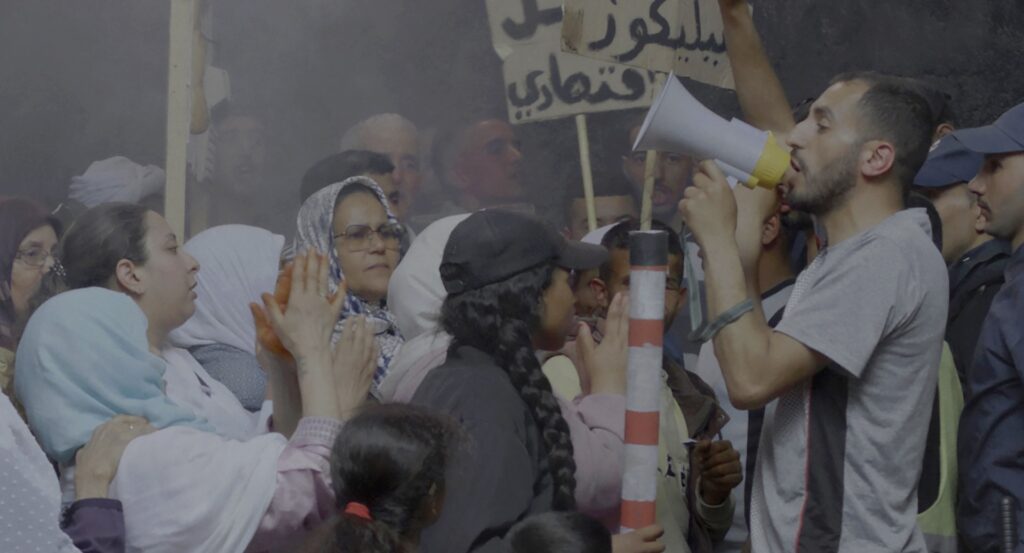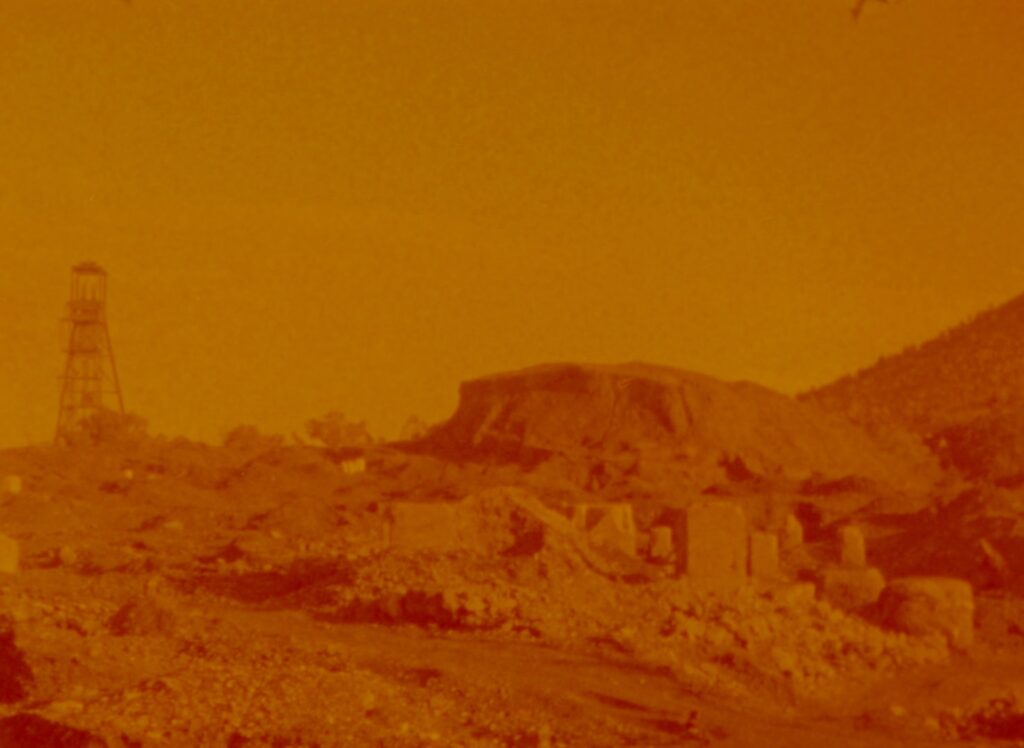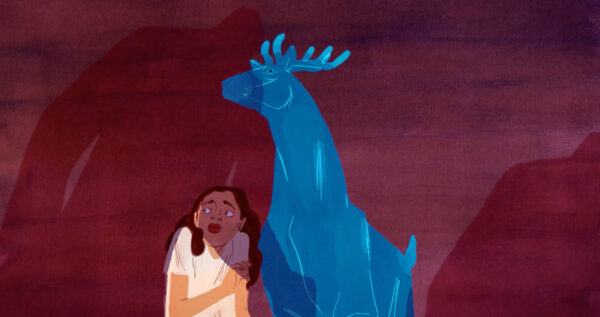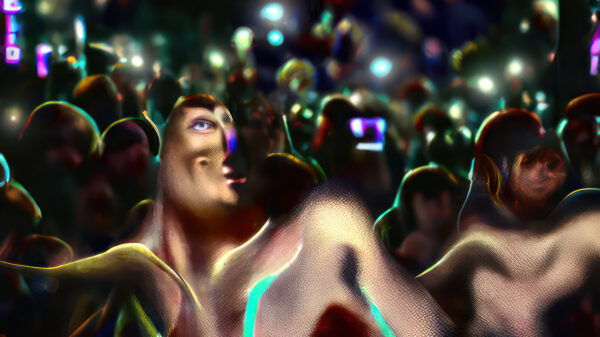Phantom Town
L’mina
Does performing daily routines before a camera shift the meaning of your work? Recreating labour in informal Moroccan mining pits in collaboration with the town’s residents, Randa Maroufi’s L’mina draws from Bertolt Brecht’s alienation effect.

“The settlers take everything except the land,” says a disembodied voice over shots of Jerada’s abandoned coal pits in northeast Morocco. In its geological endurance, the land becomes a witness to histories of both care and extraction. Once a thriving mining town, Jerada was discovered, used, and eventually abandoned for its coal—a decades-long chain of events that left the region deeply destabilised.
Directed by Moroccan filmmaker Randa Maroufi, L’mina (The Mine, 2025) focuses on this history, echoing traditions of nonfiction film about coal mining. While most of these films were intended for classroom use, recruitment, training, or sales, L’mina revises its gaze on the economy of coal mining. Departing from a strictly documentary intention, it looks at how archival veracity, forensic ontology, and reenactment can be used to make sense of (and even reclaim) a difficult chapter of contemporary history.
L’mina looks at the topology and peoples of Jerada, a town first identified by Western geologists in the early 1900s for its coal reserves. Over the following decades, the town became heavily industrialised around mining. However, by 2001, rising costs and the growing use of alternative energy sources brought the industry to a halt. With no equivalent economic alternative and many residents left unemployed, people turned to mining coal informally. These makeshift operations have cost lives, as workers continue to risk everything in the abandoned pits, demonstrating the dangers of a clandestine industry.
The danger and lack of opportunity have sparked several protests against economic neglect and unsafe working conditions. One of the most notable ones was the Hirak Rif uprising in 2016, which called for social justice, jobs, and healthcare. As director Maroufi has explained in interviews, the film recreates these events on a set designed in collaboration with the coal miners of Jerada, who also appear as themselves on screen. Even though this knowledge is not made explicitly clear in the diegesis, the film abundantly hints at the staged nature of the set throughout its duration.
It is important to note that the film’s constructed set cushions the workers from the physical dangers of an actual coal mine. This approach draws on what playwright Bertolt Brecht called the “alienation effect”. Brecht’s idea was that a performance should make its staged nature clear—through interventions like actors breaking character to speak directly to the audience, songs or choruses interrupting the action, or stage designs that leave technical elements (like lighting) visible instead of hiding them. The aim was to stop viewers from losing themselves in the illusion and instead encourage them to think critically about what they were watching. L’mina uses a similar strategy: by placing the miners in a safe, artificial version of their workplace, the film reminds us that what we are seeing is a reenactment.
The power of this choice lies in how the audience recognises the artifice and is pushed to reflect on what it means, even as it demands extra-diegetic research. One of the longest sequences in L’mina follows the coal miners in a single continuous shot. We see them sifting gravel, loading coal, climbing down into a pit, smoking, making tea over a fire, or simply resting—moments that are later stitched into a panoramic tableau in a discernible emphasis on their constructed-ness. In another scene, the camera frames the workers tightly as they crouch in the narrow breadth of an underground tunnel—the head-on view subtly establishing the theatricality of the set.

© L’mina (Randa Maroufi, 2025)
The question then arises: does my knowing that these are the actual coal miners of Jerada change how I read their labour on screen? And for the workers themselves, does performing their daily routines before a camera (knowing they are being watched) and without the same monetary incentive shift the meaning of the work?
As active participants in the making of this film, the coal miners of Jerada reclaim their agency against the totalising effect of coal on their lives. Seen this way, Maroufi’s film reflects what some call the “ethical turn” in contemporary documentary filmmaking—a shift that asks filmmakers to recognise the vulnerability of their subjects and to take responsibility for how they are represented on screen. Instead of chasing “authentic” representation in the traditional sense, the film encourages a mode of worldbuilding founded on care.
This is most evident in the film’s depiction of a mining accident. Lying flat on his chest and working on the ragged surface of a tunnel with his flashlight on, a miner taps the ceiling to sense something out of the ordinary. Alarmed by a noise, he crawls backward and out of the frame with urgency, calling out to his colleagues to rush to safety as well. Meanwhile, the static frame captures the ceiling collapsing, followed by a pervasive cloud of black smoke, which then leads to (staged) scenes of mass protest. Drawing from the real-life deaths of mine workers under similar circumstances in Jerada, L’mina bypasses the convenient portrayal of death, and instead, opts to depict the constant threat of death as a more effective tool of mobilisation that does not cost the mine worker their dignity.
Film scholar Bill Nichols uses the term “fantasmatic” to describe the political desire behind tools like reenactment. In L’mina, reenactment helps fill the gaps left by the lack of direct images of the tragic accidents tied to coal mining that befall its workers in Jerada and elsewhere—including the one illustrated above. Impossible to capture as they happen, the unfilmable duress of coal mining is made visible by treating reenactment itself as a kind of evidence. In doing so, the film satisfies the need to see what cannot be shown—a fantasmatic gratification—by producing proof through fabrication. The image then becomes a testament to the problem, even if no such image ever existed before.
As Maroufi has stated elsewhere, the film also weaves in images of the town that have been scanned using the same forensic methods the state employs for surveillance. This results in X-ray-like tracings, with the camera seemingly penetrating the surface to locate details beyond its range of vision. These 3D scans trace the outlines of real buildings and scaffolding, but what appears on screen is ghostly and hollow, dispossessing the town of its lived memories. By reworking the state’s own mapping tools, L’mina criticises how the state’s apathy has progressively rendered Jerada a phantom town, as people continue to migrate outward in search of opportunities. This speaks not only to a formal irreverence on the artist’s part but also to her cheeky subversion of the conditions of visibility that have long determined the region’s use value.
The closing moments return us to life on the ground, with Super 8 footage of the miners and their children. Here, the film lingers on an unsettling possibility—that what gets passed down is not only the occupational skills of mining, but also the exhaustion of prolonged struggles, and just as importantly, the resilience that keeps their collective resistance alive.




There are no comments yet, be the first!